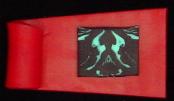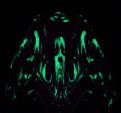| My friend Michael Marx, a long-time polymer clay artist and the
person who introduced me to the medium, showed me how to make
"swirled balls" and cut them in half to reveal interesting
patterns. Quite the opposite of millefiore canes, this technique
produces unique, unpredictable patterns.
I'm also a woodworker and one the goals I
cherish most is to bring out the beauty of the wood simply
by cutting and treating it well. There is perhaps some
ethic or belief that says that the wood speaks best for itself.

One excellent technique for exposing that beauty is the
bookmatch. The same technique works in clay and is often
used to create symmetrical canes, etc.
A bookmatch happens when you cut off a piece of material and lay it
next to the piece from which it was cut so that a symmetrical figure
is formed. This is conceptually similar to the technique that Hermann
Rorschach used to produce his famous ink-blot test. See
www.rorschach.org.
It is very easy to produce bookmatch patterns. Swirl up some
polymer clay into a ball or cube or other shape, cut it in half
and see what you get. Some of them are strikingly beautiful!
I have sat for hours many times creating bookmatches and thinking
about how the folds and other techniques I use for combining
polymer clay might result in the patterns I see.

What follows is my attempt to formalize and abstract some of
my thoughts and observations about folding fimo for my own
reasons. I want to do this as a way of keeping my art fresh.
One way for me to do that is to have some ideas about where
in my own experiences there might be lesser explored techniques
for folding the clay.
This is not the only technique I use nor the only source I have
for inspiration of new work. It is merely one of the tools I
use as I explore the amazing medium of polymer clay.
Previous Next Next
|